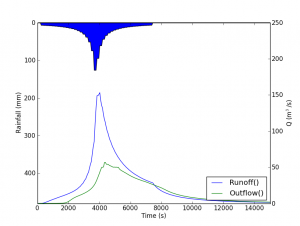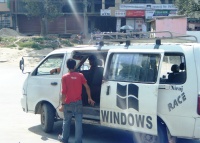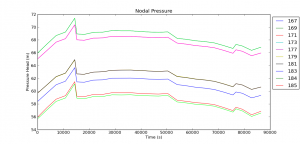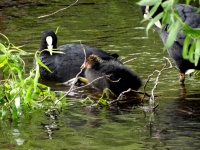Assela Pathirana
Seminar titled 'I can teach as much as I like but does it lead to learning? Musings on teaching learning and related things' given 2012-MAR-29 at UNESCO-IHE Water colloquium.
Random musings on various topics: Climate and water security, Small Island Developing States (SIDS), IT tools, Computer programming and Web-Applications, Citizen Science, ... Views are personal!
The book on Climate Change, Extreme Rainfall and Urban DrainageSome members of International Group on Urban Rainfall (IGUR) of IWA/IAHR Joint Committee on Urban Drainage[1] has produced a book on the topic on the influence on climate and other forms of future change on extreme rainfall and the implications on urban drainage systems. In addition to a state-of-the-art overview of existing methodologies and relevant results related to the assessment of the climate change impacts on urban rainfall extremes as well as on urban hydrology and hydraulics, it contains a number of tutorials on how to use the described techniques in practice. One example is an easy-to-use tutorial on how to use [Category:WRF_Model|WRF model] on personal computers. This is a similar to -- but very much improved (therefore easier to use) -- the framework described in the article "Running WRF Model on Windows". [[The book on Climate Change, Extreme Rainfall and Urban Drainage|read more...] SWMM5-PythonThis is a python module for running SWMM5 model via python and extract results as python objects. Read more.. IMHEN Report on Climte Change in Vietnam(C) Institute of Meteorology, Hydrology and Environment (IMHEN), Vietnam. IMHEN conducted the project "Impact of climate change on water resources and adaptation measures" sponsored by the Government of the Kingdom of Denmark with the participation of consulting experts from the Danish Hydraulic Institute (DHI) and the participation of many Vietnamese agencies. read more Refresher Seminar on Asset ManagementWe conduct a ten day refresher seminar on Asset Management of Urban Water Systems. It is open for the UNESCO-IHE Alumni outside Zambia. Fully paid scholarships available. Non-Alumni can also apply, but only as paid participants. Read More.. Linux Has ArrivedI have been using Linux for about twelve years. In the beginning, largely for specialized tasks, but later I found myself increasingly using Linux for day-to-day computing activities. Today, it has grown into a truly user-friendly, powerful, yet unassuming system that provides a very viable system for home, office and educational computing. Especially the many features of today's Linux systems make them exceptionally well-suited for educational use. Read More Running WRF Model on WindowsWRF Model runs on UNIX platforms only. While this generally is not a problem for dedicated research or forecasting entities, for the casual user having access to only a Windows computer is faced with difficulties in trying out the modeling system. It is quite possible to install a UNIX-like operating system (e.g. Linux, BSD) alongside Windows, the technical details involved is enough to keep casual user from doing that. With the introduction of a number of a number of Virtualization solutions by various entities another path has become open to try Linux tools on Windows. That is to use a Virtual_machine envornment that runs a Linux operating system within a virtual computer that is installed within windows. The beauty of the approach is the fact that the user does not have to be tech-savvy to use such a solution. Once a good setup is designed and implemented, it will run practically on any windows computer that is reasonably powerful. Read on for details ... |
Improving Drinking Water Quality without Compromising Long-term SafetyTreating water with chlorine is a time-tested way of ensuring biological safety of drinking water. However, excessive chlorination creates chlorination by-products, that are known to cause long-term risk of cancer. We attempted to make a safe compromise. We integrated EPANET2.0 (a steady-stage, demand-driven water distribution network model), a particle back-tracking algorithm (can trace the origin of water delivered at any demand point in the network), chlorine and disinfection by product model and a multi-objective optimization algorithm to enable computing the optimal water treatment, minimizing long-term chemical risk (represented as cancer treatment cost.) Read more... EPANET-PythonWhen I started teaching programming for water professionals at UNESCO-IHE, I was compelled to use C/C++ as the language. This is due to the fact that EPANET2.0 and EPA-SWMM5.0 (Two main programes, students in my department had to learn) were written in C language. However, C/C++ is a horrible first language. Students have to cover at least three days of learning of arcane syntax and rules before they begin to write some semi-useful code. On the other hand, if I could conduct the classes in Python, they will see the `light' within a few hours! They can start doing interesting and useful things from the very beginning of the study. What a way to stimulate learning! I wanted to make it possible to call EPANET2 and EPA-SWMM5.0 procedures from python. Following is the first attempt: Read More... Capturing and Converting Digital Camcorder VideoThere are hundreds of software applications that can capture Digital Video from a digital tape camcorder. Some for money and others for free. However, faced with several shoe boxes full of Mini-DV tapes, what I needed was a nearly automatic system. Like pop-in the cassette to the camcorder and `press a button' to get the whole content of the cassette captured, deinterlaced and transcoded to MPEG-4 -- a format that is far more suitable for computer storage and playback. Read More Mirroring LAMP WebsiteThis web site runs on Mediawiki with MySQL backend (Read details here: Mediawiki for personal webs. This is the story of setting up automatic syncrhonisation between my development machine (DM) and the (cheap, no-frills) web hosting account. Read More Cross Compiling C and FortranRecently I had to mix two large models written in C and Fortran (95 standard) to build a single monolithic program. In theory cross compilation is easy -- in practice its far from it. Your run off the mill 'hello world' implemented in C and called from Fortran (or vice versa) is one thing, but marrying off two large programs (numerous code files in each) written in two languages is a whole different story. Following is an account of my experience: Read More Dependency Walker -- A remedy for distribution headachesIf you have ever tried to give away a reasonably complicated program that was written and compiled on windows to another user you should be very familiar with complaints of missing DLLs, and other dependencies and module mismatches etc., etc. These erros can manifest themselves in many forms (The procedure entry point could not be located in the dynamic link library; The application or DLL is not a valid Windows image or even Program too big to fit in memory.) This is particularly so if you happen to be developing with a complex build environment that is tightly integrated with windows system, like visual studio (I often use Visual C++ 2005/2008 express (free) editions and they create a lot of trouble in deployment!) read more... Remote Editing in UNIXUnlike Windows, UNIX computers were always meant to be accessed both locally (in front of the computer) and remotely (from somewhere remote). Even with today's high speed network communications, editing with a graphical editor like gedit over the network can be a tedious experience. You hit a button and wait ages for the user interface to be updated!. Of course if you are comfortable with vim or emacs editors which don't need any graphical interface, they you are fine. But for those who don't know these, there is WinSCP. Read more ...
|








